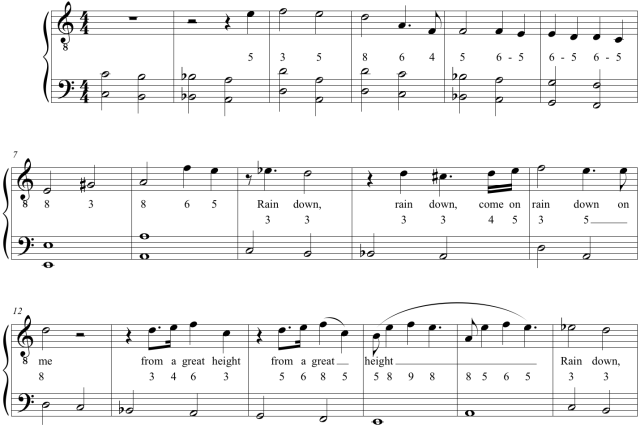At about 3:33, Radiohead’s song Paranoid Android clearly references “classical” (really, probably, Baroque or earlier) music. There’s a bass line that repeats, a bit like a ground bass; this bass line involves descending chromatic motion, as many ground basses do; the texture highlights vocal lines rather than the quiet guitar accompaniment; the music sounds as if it is in a very resonant space like a cathedral; and… there are clear references to old practices of counterpoint!
There’s lots to talk about in this piece, including this section’s role in a rather strange musical form, but in this post my focus is purely on counterpoint. In fact, we can even bring approaches from species counterpoint, because the rhythmic relationship between the low voice(s–this is always doubled in octaves) and the lead singer is often one-to-one. This is really unusual and part of the “classical”-ness of the passage, since most pop/rock music has quite a few melody notes per bass note.
A transcription of the first two times through the bass line is below. I’ve followed the usual practice of annotating intervals between outer voices in between the staff. Somewhat arbitrarily, I’ve used 8 for unisons and octaves, 3 for thirds and tenths, etc. One thing apparent right away from the transcription is that, just as in species counterpoint, a heavy emphasis is placed on consonances: 8ves, 6ths, 5ths, and 3rds. Dissonances are only used as brief anticipation (4th, m. 4), metrically weak passing tone (4th, m. 10; augmented 4th, m. 13), and, most dramatically, syncopated half-step neighbor tone (minor 9th, m. 15).

One interesting thing: 6ths are treated like a dissonance surprisingly often. Check out m. 6, where I’ve annotated each 6-5 motion as if it were a suspension. In each case, the 6th is prepared on the previous beat by a consonance, and then after it sounds it resolves down by step. This effect is echoed two measures later in m. 8’s 6-5 figure, though this one isn’t prepared.
But the Most Interesting 6th Award goes to m. 16, an almost exact repeat of m. 15 over new harmony. In fact, these two measures are the most interesting in general, as the only clear contrapuntal rule-breaking happens here, with a disorienting parallel-fifths shift down by half step into m. 15, followed by the only syncopation in this section. (I know, mm. 5–6 imply underlying parallel fifths too.) This syncopation rises a dramatic half step to a 9th in m. 15. But the same figure rises a dramatic half step in m. 16 to a 6th—which is, to me, no less wrenching!
